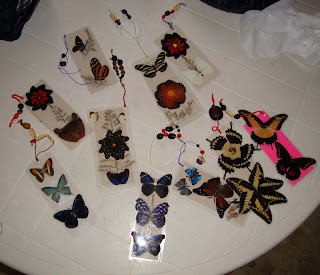March 26, 2010
We arrived here at Chajul Biological Station yesterday afternoon. Getting to the small town of Chajul used to be a full day's drive on very bad roads. Now it's just a few hours on paved roads from either of two international airports. It's then a half mile boat ride to the dock of the biological station, which sits at the foot of one of the largest tracts of wilderness in Mexico. Enter the words "chajul, mexico" into the search field at maps.google.com, and be sure to click on the "Satellite" option.
This is the Dining Hall and one of the tame "rescue" Scarlet Macaws cavorting in the lower branches of the tree.
We birded from the clearing where the buildings are and walked a few miles of trails. The birding here was outstanding. On our one full day here, we tallied 139 species within about a kilometer radius, and added another 12 the next morning. We arrived when Plumbeous Kites were returning from their wintering grounds in South America.
We found many birds to be very responsive to our whistled imitations of pygmy-owls and on our last morning here were thrilled to have this Central American Pygmy-Owl come right in behind the buildlings. I had heard a few of these (in Oaxaca, Belize, and Costa Rica), but this was the first I've ever seen.
Here is the back of its head showing the fake eyespots.
For a while I thought the blob on the top of the radio antenna had some odd function. then I looked at it through the scope and saw it was a wasp nest.
One trail took us about 1.7 kilometers through rainforest, past a very small Maya ruin, and ended up on the shore of the Lacantun River.
There were some nice damselflies here, including this Dusky Dancer, Argia translata.
This rubyspot is probably Hetaerina cruentata. Thanks to Dennis Paulson for the names.
There were a few butterflies along the trail. This is probably Fruhstorfer's Owl-Butterfly, Caligo oedipus fruhstorferi.
This skipper is probably the Shy Saliana, Saliana longirostris (thanks to Richard Lindstrom for the suggestion.)
These wild looking caterpillars feeding on a plant in the family Malpighiaceae may be notodontid moths (thanks to Jim Brock for the suggestion.)
This skipper could be either Tanna or Teleus Longtail.
There were some nice herps here. This is Norops capito, the Pug-nosed Anole.
This is a young Giant Toad, Rhinella marina.
This is a Gulf Coast Toad, Incilius valliceps. (Yes, notice all the new toad genera, once all Bufo.)
This is Diploglossus (or Celestus) rozellae, Rozella's Galliwasp. I recognized it as a member of the alligator lizard family, but had never seen one in the tropics before. It turns out to be an arboreal species, rarely seen as it's normally 30 or more feet up in the epiphyte clusters. This one must have recently fallen down.
This very large (about 51/2 feet) snake skin was stretched across the trail. They don't last long in the tropical rainforest (quickly recycled by scavengers), so this must have been left very recently.
There was a terrific diversity of elegant understory palms here, most in the genus Chamaedorea. This one is Reinhardtia gracilis.
In addition to the tame Scarlet Macaws, there are a couple of orphaned Great Curassows (one that bullies people), and a couple of orphaned White-nosed Coatis. This one liked the smell of Negra Modelo.
One of the ways local people have tried to make money is by creating arts and crafts from butterfly wings. These are a series of bookmarks. This sort of economic activity is encouraged with the theory that the people will understand that there will be no butterflies if they continue to cut down the rainforest. Collecting live adults usually has little impact on populations. As long as a few remain to lay their hundreds of eggs, insect populations are designed to be able to sustain high mortality rates.
Tuesday, April 6, 2010
Subscribe to:
Post Comments (Atom)



























No comments:
Post a Comment